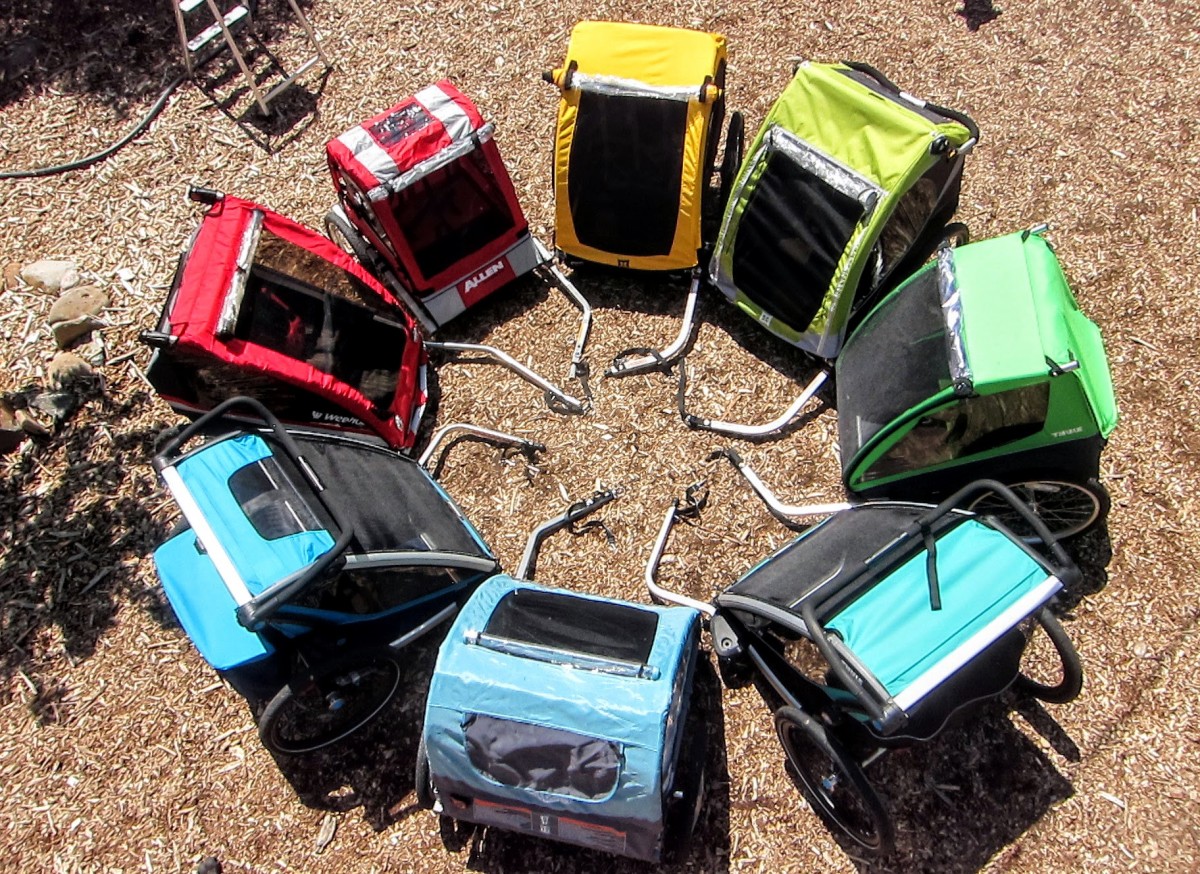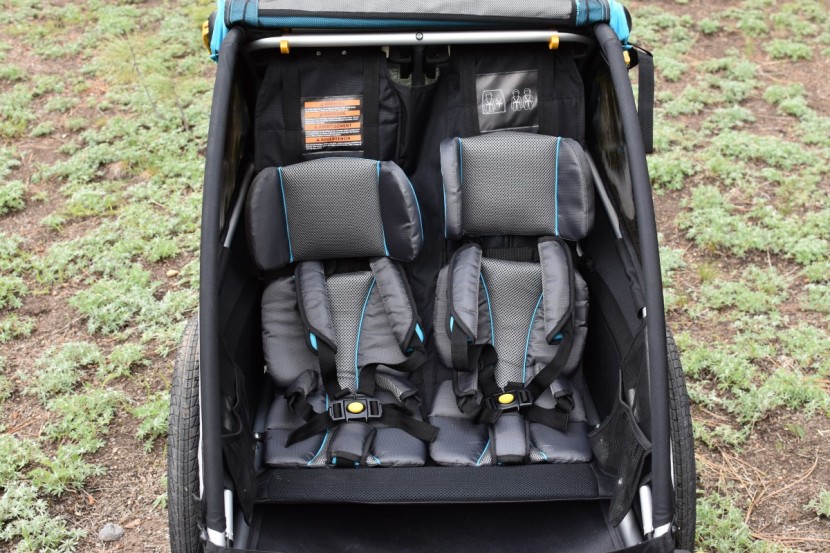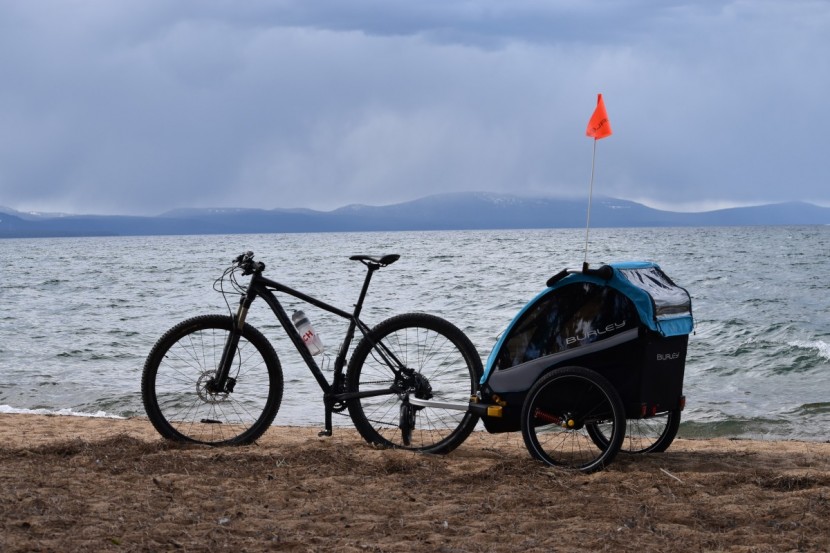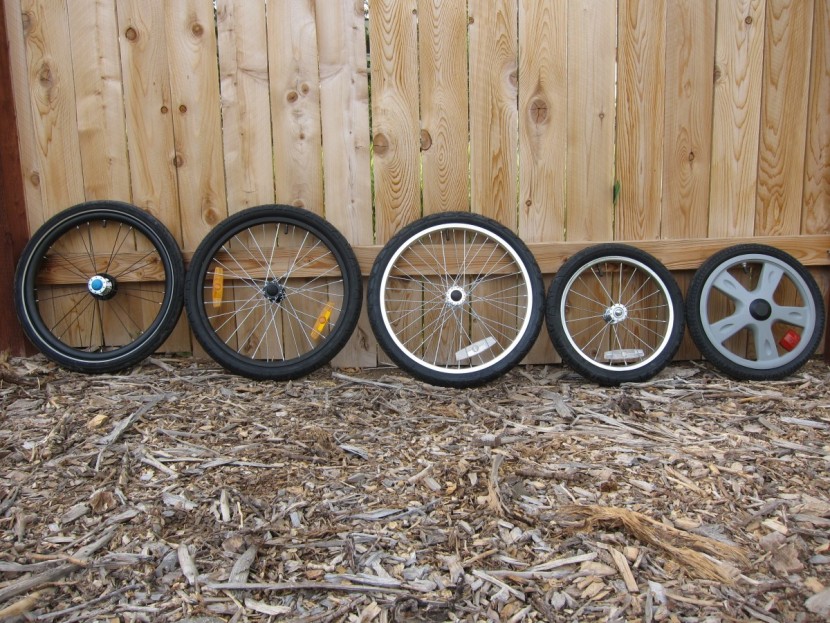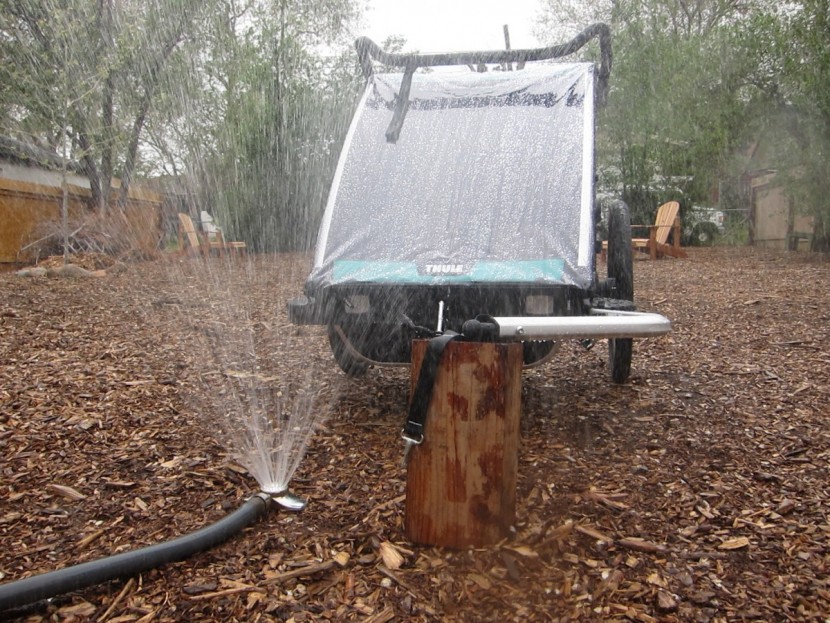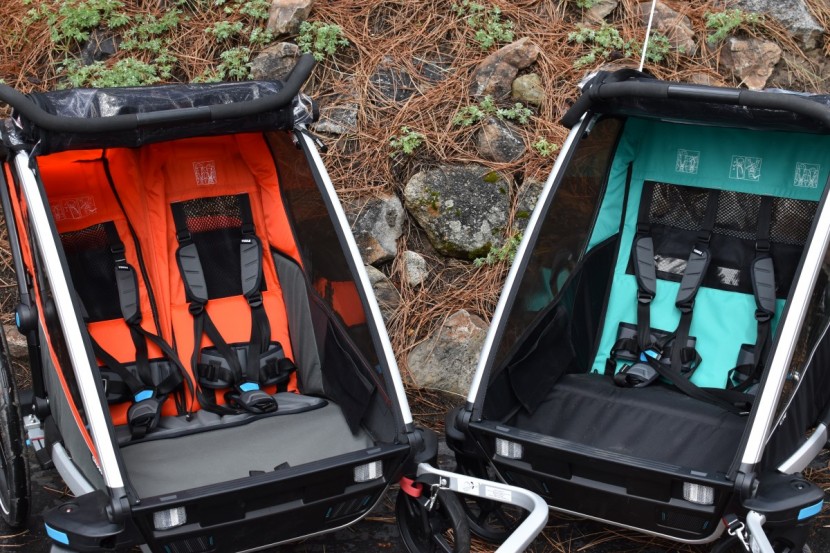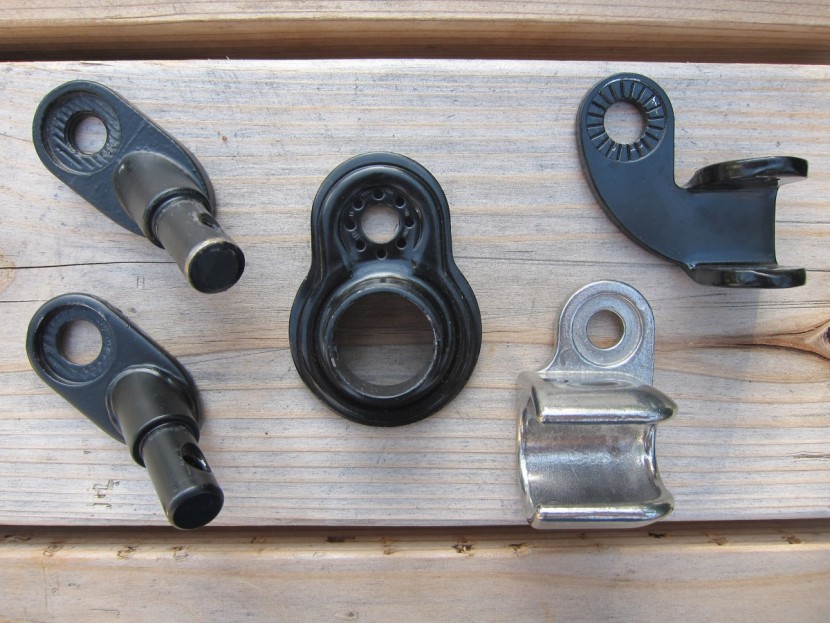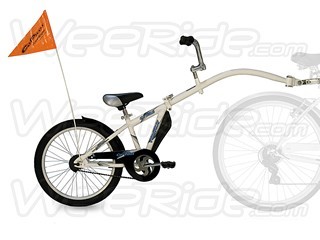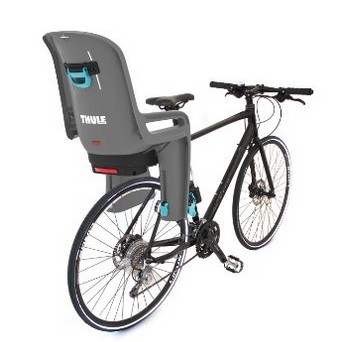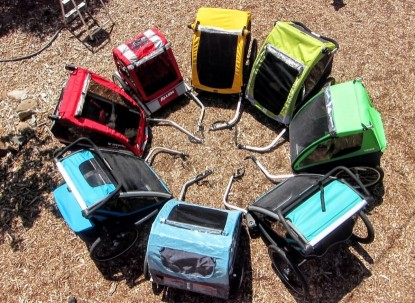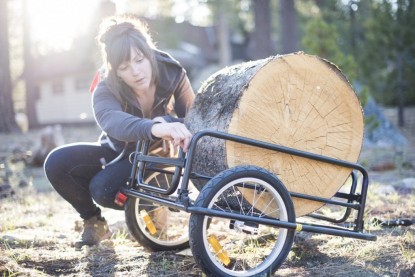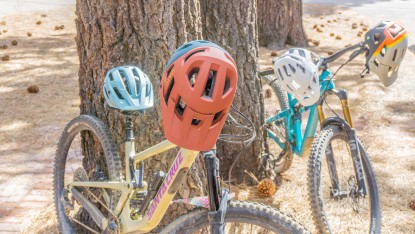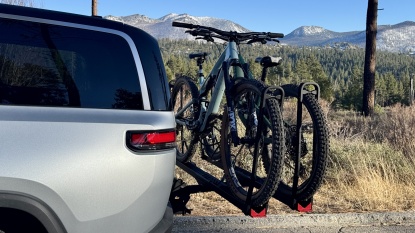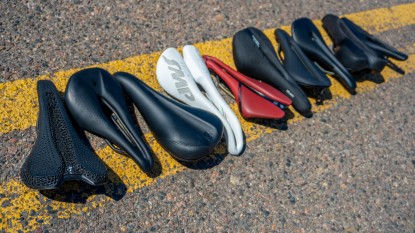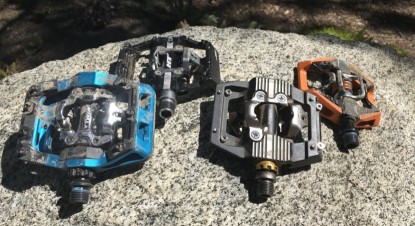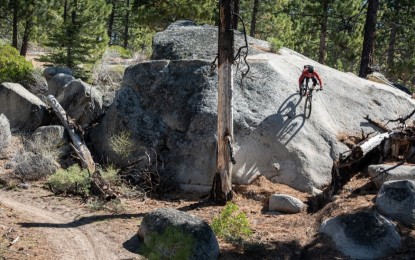Choosing a bike trailer can be overwhelming given the number of options on the market today. How do you choose the right bike trailer for your family? Should you invest in the best model on the market, or choose a budget option? As your children get older, does your trailer have a natural expiration date? How do you know if a standard trailer is the right product for your needs in the first place? Here, we'll steer you through your choices and provide a step-by-step guide to purchasing the right product for your family, lifestyle, and wallet.
Selecting the Right Standard Trailer
If you know you want a standard bike trailer (basically, a stroller that attaches to the rear axle of your bike) but aren't sure which one is right for you, you've come to the right place. If you're not sure you want a standard stroller, check out the Ways to Haul Kids with Bikes section at the end of the article.
To find the right trailer for you, think about how old your kids are, how many you do or will have, how often you'll take them biking, what kind of weather you'll be contending with, and how much you want to spend.
How Many Kids Do You Have, and How Old?
The models we tested are all suitable for carrying children 12 months and up. Some manufacturers, like Thule, offer an infant insert that they say makes trailers appropriate for even younger children, but our friends at BabyGearLab have researched this issue extensively and don't agree.
We defer to their conclusion that you should wait to use bike trailers until your child is at least a year old and has the ability to hold his or her head upright even when in a bike trailer. Your pediatrician can help you analyze whether your child has sufficient head and neck strength to begin rolling in a bike trailer. In all cases, children should be secured with the trailer's harness and should be wearing a well-fitted helmet while riding. There is never a good excuse for not having a helmet on a child when he or she is in a bike trailer.
The trailers we tested are appropriate for carrying a maximum weight of between 80 and 100 pounds. Most children will outgrow a trailer because they will be too tall to comfortably fit inside it rather than because they have grown to be too heavy. Most 5 year olds will find that even the roomiest trailers will not accommodate their outstretched legs without having them protrude from the main cabin, which is unsafe.
We tested two-child trailers so we could make direct comparisons across brands, but all of the models we tested either have a one-child version or a similar one-child option. Refer to the manual that accompanies each trailer, but most manufacturers recommend that single children should ride in the left seat (as you look at the front of the trailer) if they are riding alone. Since trailers are towed behind human-powered bicycles, manufacturers must balance the cyclist's need for a light, aerodynamic caboose with the passenger's need for space to sit comfortably. As a result, even two-child trailers are relatively narrow, designed to fit two tushes with very little room in between or on the sides. If your kids are prone to squabbling in close quarters, beware!
If you have two kids and are looking to maximize the space they have inside the trailer, we'd recommend the Hamax Outback. It has one of the widest seats we tested at 24", and we noticed that our passenger testers looked more relaxed and less squished in the Outback than in any other trailer. Keep in mind, though, that this extra passenger space equates to extra weight for the cyclist — the Outback was also our heaviest model by far. The Burley D'Lite models also feature a nice wide passenger area at 22.5", and it has extra framing at kid shoulder-height to bow the trailer out at the sides, giving passengers more room.
If you are only towing one kid, you could opt to go with a one-child version like the Burley Solo. But consider this: most one-child versions are almost as expensive as their equivalent two-child options (for example, the D'Lite is only about 15% more expensive than the Solo). With a two-kid trailer, you get significantly more space for your kid to spread out, increased versatility in towing cargo, and the option to bring an occasional friend along. For these reasons, you should consider purchasing a two-child option even if you only plan on towing one passenger.
If your children are on the younger side, it might be worth it for you to invest in one of the higher-end, more durable products on the market, since you'll be able to pull your kids in the trailer until they outgrow it, rather than until the trailer falls apart. If that's the case, we will steer you toward one of the Burley or Thule models, especially the Burley D'Lite X or the Thule Chariot Cross, since they're incredibly well constructed and won't wear out before your kids are finished enjoying them. The Hamax Outback is also a very well-made, durable option, if you don't mind pulling a heavy trailer. If you're looking for a way to tow kids nearing the end of their trailer days, it might make sense to spend less on a product you'll only use for a year or two. In that case, the Burley Bee, winner of our Best Bang for the Buck award, is still a fantastic and well-built trailer at a reasonable price.
Where Will You Ride, and How Often?
When deciding which trailer to purchase, the type of terrain you plan to access should be a central factor. Consider how you plan to use your trailer. Do you see yourself hauling your kids along on training rides up and down difficult mountain roads? Are you investing in a trailer to help you ditch your daily car commute? Or are you envisioning the occasional cruise over paved roads to the local park?
If you're planning on regular off-road riding for prolonged stretches, we'd strongly recommend investing in a trailer with a suspension system, like our Editor's Choice award winner, the Burley D'Lite X, our Top Pick for Athletes, the Thule Chariot Cross, or our Top Pick for a Comfy Ride, the Hamax Outback. Having built-in suspension makes the trailer easier for you to tow and creates a much smoother ride for your passengers, which is more important the younger your children are.
If you're going to be doing any off-road riding at all, you'll thank yourself for choosing a trailer with 20" wheels, which are significantly easier to tow over rough terrain. You can improve performance off-road, over sand, or over snow even more if you purchase an accessory wheel kit offered by some manufacturers like Burley. The trailers we tested with smaller, thin 16" wheels, the Allen Sports Steel and the InStep Take 2, are best-suited for paved road riding.
If you plan to use your trailer for commuting or other daily activities, the Burley Bee is our favorite affordable option, and the Burley D'Lite X is an excellent choice at the higher end of the price range. Both of these trailers are a joy to set up and tow, and they're durable enough to stand up to daily use. If you are staying on paved roads but live in a community with lots of hills, we'll put in another strong recommendation for the Bee. It's the lightest trailer we tested, and it has the most robust hitch mechanism, so it doesn't transfer any lurching to the bike even when standing up on hill climbs.
The Hamax Outback is another excellent option for commuting, since it's durable, has a roomy cargo space, and is super comfortable for kids. However, if your commute takes you up any serious inclines, steer clear of the heavy Outback and check out a lighter option, like the D'Lite models or the Bee.
How's the Weather?
Most trailers on the market tout their weather-resistant properties, but we found a wide variation in the performance of the models we tested. If you are regularly riding in very wet or hot environments, spend some extra time inspecting the trailer you're considering.
If wet weather is a serious issue for you, look for an extensive rain shield that protects the top and the front of the trailer to the footwell. The Thule Chariots both sport this type of coverage and were the only models we tested that we would consider taking out in a downpour. The other models we tested did not have adequate coverage and saturate during prolonged rain exposure. Also, pay attention to the bottom of the trailer. Splashes from the road and spray from the rear bike tire may soak through fabrics like canvas.
If sun exposure and high temps are your concern, consider opting for sunshades, mesh-covered ventilation openings, and UPF windows. The Burley D'Lite models sport all of these accouterments. The Thule Chariots have excellent sunshades and ventilation. And the Hamax Outback has solid ventilation and windows with UPF 30.
How Much Do You Want to Spend?
Some bike trailers cost as much as a nice dinner out. Some cost as much as a plane ride to Tahiti. The Schwinn Echo and the InStep Take 2, which both retail for $140 and are frequently found on sale for less, are the least expensive models we tested. On the other end of the spectrum, our priciest test product, the Thule Chariot Cross, retails for a cool $1,150.
Of course, your budget is entirely your business, but we do have a few helpful thoughts here. For the most part, we recommend springing for the big step up to suspension models, especially if you plan on using your trailer at least several times a month. The more pleasant experience will encourage you to use it more often, lowering the cost per ride over time. The Burley D'Lite X is our top recommendation for its combination of stellar performance and more reasonable price point. At the top end of the price spectrum, the Thule Chariots also offer excellent performance. If you're going to jump up into this price echelon, we recommend getting the Cross version. An investment at that level deserves to be rewarded with top level performance.
Keep in mind that true gearheads may be tempted to continue to spend big bucks on trailer accessories, such as conversion kits, lights, storage covers, and other upgrades. None of this comes cheap, and if you truly want to take advantage of the versatility of a high-end trailer expect to shell out several hundred dollars more. For example, ski conversion kits are about $250 a pop.
If you know that you're only going to be biking on smooth paths, your children are likely to age out of the trailer within a year or two, or you're just not likely to use it often, consider a budget buy. In this test, the Burley Bee stood out as an excellent value at $300. It's a snap to set up, tows easily, has solid safety features, and is light enough to load up with kiddos or cargo. While it's twice as expensive as the cheapest options in the test, it's superior comfort and ease of use ensures that you'll get a lot more mileage out of your purchase. If budget is your top priority, based on our testing, the Schwinn Echo is the best of the rock-bottom-priced trailers.
Will It Fit Your Bike?
Most bike trailers will work with most bikes, but will your bike trailer work with your bike? In modern bike trailer designs, a big part of the answer to this question comes down to the hitch.
All of the trailers we tested have hitches that attach to the bike with a steel adapter that's clamped to the bike frame by the rear quick release skewer. For this to work, there has to be enough of a flat surface on the frame dropout area to accommodate the hitch adapter. For bikes with flat dropouts, this usually isn't a problem. For bikes with “breezer” style dropouts that have protruding hoods (resulting in smaller flat surfaces), it often is a problem and may make the bike incompatible with individual trailers.To determine if a trailer's hitch adapter will work with the bike you have, check to see if you have breezer style hooded dropouts or flat ones. If your dropouts are flat, any of the trailers we tested will most likely work with your bike. If you have breezer style dropouts, it's worth calling the manufacturer and telling them the make and model of your bike so they can say whether the hitch adapter will fit or not. We attempted to test each of the trailers with a 2016 Novara Randonee with breezer style dropouts. The Burley and Thule hitches fit easily. We were able to make the Weehoo, Allen, Schwinn, and Hamax hitches work, but they are about a millimeter too big. The InStep hitch was way too big to work with breezers.
If the bike you want to use has tight breezer-style dropouts that won't work with any hitch adaptors, don't fret. Burley sells a $12 hitch adaptor that can solve this very problem. It also offers its classic hitch design that attaches directly to the chainstay for $30. There is also a chainstay adaptor for Thule models available for $40. The chainstay options will be a little heavier and clunkier to use than the elegant QR-based hitches, but they're certainly a cheaper option than buying a new bike!What's Next?
We know this will make some parents sob, but your kids won't be trailer-aged forever. Considering your plans for your trailer once your children are pedaling their own bikes can help you decide how much to spend and which model to choose.
If you're planning to give your trailer to another family or sell it used when it's no longer appropriate for your kids, it makes sense to invest in a trailer that's well-constructed, well-designed and durable. The Burley D'Lite models and the more-affordable Burley Bee are great options here, as are the Thule Chariots. The Hamax Outback is well-constructed and extremely durable, so it will likely hold its value as well. Lower-end trailers like the Schwinn Echo, the InStep Take 2, and the Allen Sports Steel are probably not great options for long-term use or resale due to their overall lower quality of craftsmanship and construction.
If you're planning to keep your trailer when your kids are finished with it to haul canines, camping gear, groceries or just about anything else, the Burley D'Lite is the best choice. As we've mentioned, the large and convertible interior of the D'Lite models make them the most versatile of all the trailers we tested. Its large wheels and suspension system make it an ideal off-road companion for your weekend bikepacking adventures. The Hamax Outback has many of the features that make the D'Lite models versatile, but its high weight is a limiting factor. Towing a 60-pound canine tester in the Outback was very difficult given that the trailer itself weighs more than 40 pounds.
Ways to Haul Kids with Bikes
There are several options for bringing kids along on bike rides, and the term “bike trailer” might mean different things to different people. The right choice for you depends on how old your children are and what they're able to do, the type of riding you want to do, and whether you hope to transport anything other than your kids — including groceries, dogs, camping equipment, and anything else you can dream up.
Standard Bike Trailers
Standard trailers, which were what we tested during this review, have two wheels and an enclosed or partially enclosed compartment for one or two children. Kids are buckled into their seats with a harness that's similar to what you'd find in strollers — usually either a five-point system like the Burley D'Lite models or a three-point system with an additional lap belt like the Thule Cadence. In a standard trailer, the only thing the passenger needs to do is sit back and enjoy the ride. The trailer connects to the bike with a tow arm that attaches to the bike frame at a single point. All of the trailers we tested attach to the bike via an adapter that's mounted by the back wheel's quick release skewer. Some other models, particularly older ones, attach to the frame or to the seat post.
Pedal Trailers
Pedal trailers, such as the Weehoo iGo Pro and the WeeRide Co-Pilot, are not enclosed and do not offer as much protection for the child as a standard trailer. However, they do allow the child to pedal and contribute to forward momentum, which can be more fun and engaging for adventurous kiddos who get bored hanging out in a standard trailer. These models are ideal for older children who are either not quite ready to ride a bike on their own but want to participate, or for children who are already capable of riding a bike but can't quite keep up with the group on their own bike. Pedal trailers can allow a parent and child to have a longer, more enjoyable ride together than if the child was on their own separate bike. This style of trailer attaches to the seat post of the adult's bike and has one wheel with a seat and crank system to allow the child to pedal.
Bike Seats
Child's bike seats, like the Thule RideAlong, are usually mounted on the front of the bike near the handlebars or the back of the bike via the frame or rack. Like bike trailers, bike seats don't require any input from the passenger other than to sit back and enjoy the wind in their hair. Bike seats are significantly less expensive than trailers, but they usually offer no protection from the elements, and they are not designed to tow any form of cargo. In addition, there is an increased risk to the child due to the height they would fall from if the bike tips over. Because of their size and positioning, they are also better-suited to slightly younger children than bike trailers are. If you just want to get your little kid out for some fun rides in good weather, a bike seat is a good option to consider. If you want to haul bigger kids, more kids, or kids plus stuff, a standard bike trailer makes more sense.

